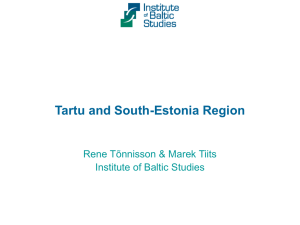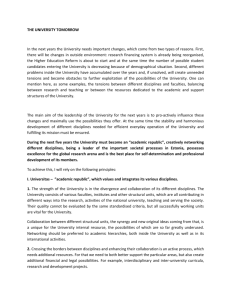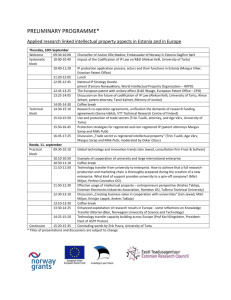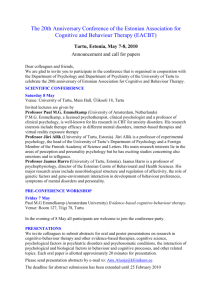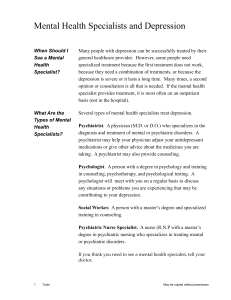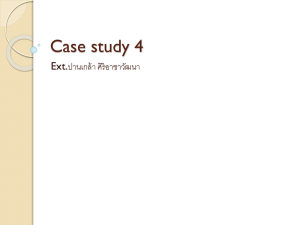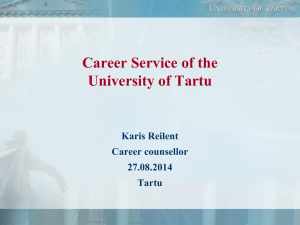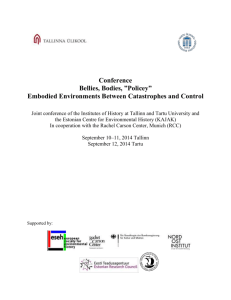WHAT HAPPENED AFTER FALUN:
advertisement
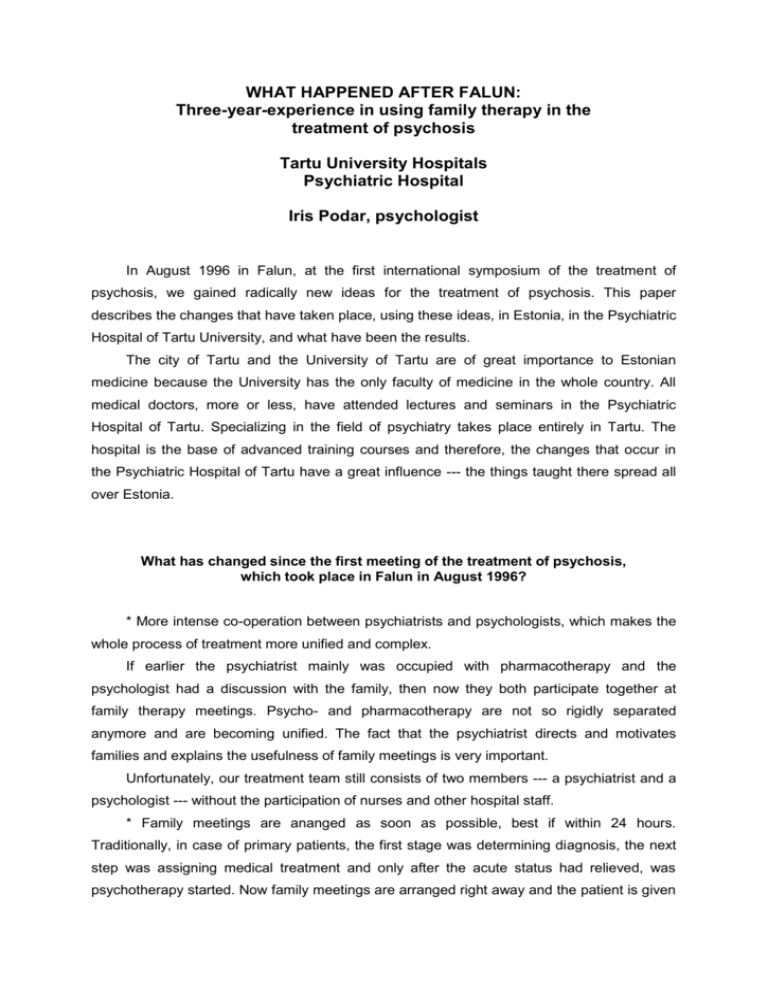
WHAT HAPPENED AFTER FALUN: Three-year-experience in using family therapy in the treatment of psychosis Tartu University Hospitals Psychiatric Hospital Iris Podar, psychologist In August 1996 in Falun, at the first international symposium of the treatment of psychosis, we gained radically new ideas for the treatment of psychosis. This paper describes the changes that have taken place, using these ideas, in Estonia, in the Psychiatric Hospital of Tartu University, and what have been the results. The city of Tartu and the University of Tartu are of great importance to Estonian medicine because the University has the only faculty of medicine in the whole country. All medical doctors, more or less, have attended lectures and seminars in the Psychiatric Hospital of Tartu. Specializing in the field of psychiatry takes place entirely in Tartu. The hospital is the base of advanced training courses and therefore, the changes that occur in the Psychiatric Hospital of Tartu have a great influence --- the things taught there spread all over Estonia. What has changed since the first meeting of the treatment of psychosis, which took place in Falun in August 1996? * More intense co-operation between psychiatrists and psychologists, which makes the whole process of treatment more unified and complex. If earlier the psychiatrist mainly was occupied with pharmacotherapy and the psychologist had a discussion with the family, then now they both participate together at family therapy meetings. Psycho- and pharmacotherapy are not so rigidly separated anymore and are becoming unified. The fact that the psychiatrist directs and motivates families and explains the usefulness of family meetings is very important. Unfortunately, our treatment team still consists of two members --- a psychiatrist and a psychologist --- without the participation of nurses and other hospital staff. * Family meetings are ananged as soon as possible, best if within 24 hours. Traditionally, in case of primary patients, the first stage was determining diagnosis, the next step was assigning medical treatment and only after the acute status had relieved, was psychotherapy started. Now family meetings are arranged right away and the patient is given the opportunity to participate in all these discussions, whatever state he or she is in. Everything, the illness, medication and need for hospitalization, is discussed in the presence of the patient and family members. We still do not have rooms where the patients and the family could stay overnight if an agreement about the need for hospitalizatron is not reached and the discussion should be continued the next day. Neither have we arranged treatment meetings in patients' homes. * Treatment meetings will continue even after discharge from the hospital, until there is need for it. Earlier, the patient was given great attention during hospitalizatron but after the patient's status had stabilized and he or she had been discharged, the contact was cut off. Now the time intervals between family sessions may increase later on, but family meetings will continue for as long as the family feels the need for them. Since in the structure of the Psychiatric Hospital of Tartu, the hospital and outpatient clinic are not strictly separated, the patient is guaranteed the same psychologist and psychiatrist. The deficiency is that all the family meetings take place in the hospital, even after discharge. It would be better to have a more neutral place for these meetings, especially if a lot of time has passed since hospitalization. While visiting the hospital, the negatively affected memories may actualize and the former patient may feel hopelessness while meeting the same chronic patients. What has changed in the essence of treatment? * The treafinent is more patient-family oriented than subjected to strict rules. The psychiatrist and the psychologist are not experts but simply people who have a lot of experience and knowledge in the field of psychiatry. The family does not need advice or expert-assessments but to be understood and supported. Team members and family members are co-experts. During the first meeting, the members of the family are so anxious that the aim is to reduce the level of anxiety and tension. In order to do so, it is important that every participant in the family meeting gets a chance to speak, ask and express their opinions, and that everybody's voices are heard, even the psychotic patient's "crazy" talk. The context of psychosis is meaningful for the family members. Psychosis is like a signlanguage that needs to be decoded and decoding needs the cooperation of professionals and family members. It has been amazing to experience how much information is hidden in the psychotic patient's remarks, that at first seem meaningless and lousy. 2 * The center of decision-making and responsibility has gradually moved from the professionals to the family. The task of the professionals is to give as much information as possible, for example what are the different methods of treatment, which are the mechanisms of treatment action, side-effects, how long could the treatment process last, etc. --- everything that can be placed under the concept "psychoeducational". And the more educated the family becomes of the members illness, the more capable of making decisions it will become. This whole process could be called "demystifing the mental illness". Regular family meetings that usually last for an hour and half, give professionals the opportunity to get enough feedback in order to trust the patient and the fainily and have belief in the hidden resources of the family. * Everything is discussed openly in the presence of everybody. Earlier' there were different talks depending on whether the patient was present or not but now we are trying to avoid that. If somebody (staff or family member) wants to say something in private and secretly, then we will encograge them to bring it up during the family session. Our three-year-experience has confirmed that discussing things openly is of no harm to the patient`s mental health, while the same cannot be said about hidden topics. Statistics The catchment area of the Psychiatric Hospital of Tartu University includes 5 counties in central and southern Estonia, the total of 312.000 inhabitant s. 90% of the patients treated in the hospital are from this region and 10% from another place in Estonia. During the last three years we have diagnosed 175 first episod schizophrenia patients (F20), including 86 male and 89 female. There are 4 inpatient units in the Psychiatric Hospital: acute, subacute, neurosis and the children's unit (with 140 beds) and an outpatient unit. Three years ago we started working with the families of psychotic patients in the subacute unit but now it has expanded into the children's unit and the acute unit. The following data describes what has taken place in the subacute unit. 3 Table 1 Primary patients with psychosis treated by family therapy since September 1996 in the subacute unit of Tartu Psychiatric Hospital. Groups Completed treatment Number of patients 16 Number of rehospitalizations 0 Continuing treatment 12 1 Canceled treatment 8 6 Total 36 7 36 patients have been treated by family therapy, which makes almost half of the unit's first episode patients. Of these 36, 16 have completed the therapy, 12 are continuing and 8 canceled. Of these 8 who canceled the therapy, 6 have been rehospitalized at least once. The length of family therapy has varied, the minimum length has been 2 months, the maximum 3 years. In case of some families more than 30 family therapy sessions have taken place but the lenght of therapy is not directry connected with the succsess of treament. Some of those who cancered family therapy were the very first ones with whom we were too enthusiastic to do traditional family therapy. The more experiences we gained, the more flexible we became and now there occur almost no cancellations of therapy. 4
